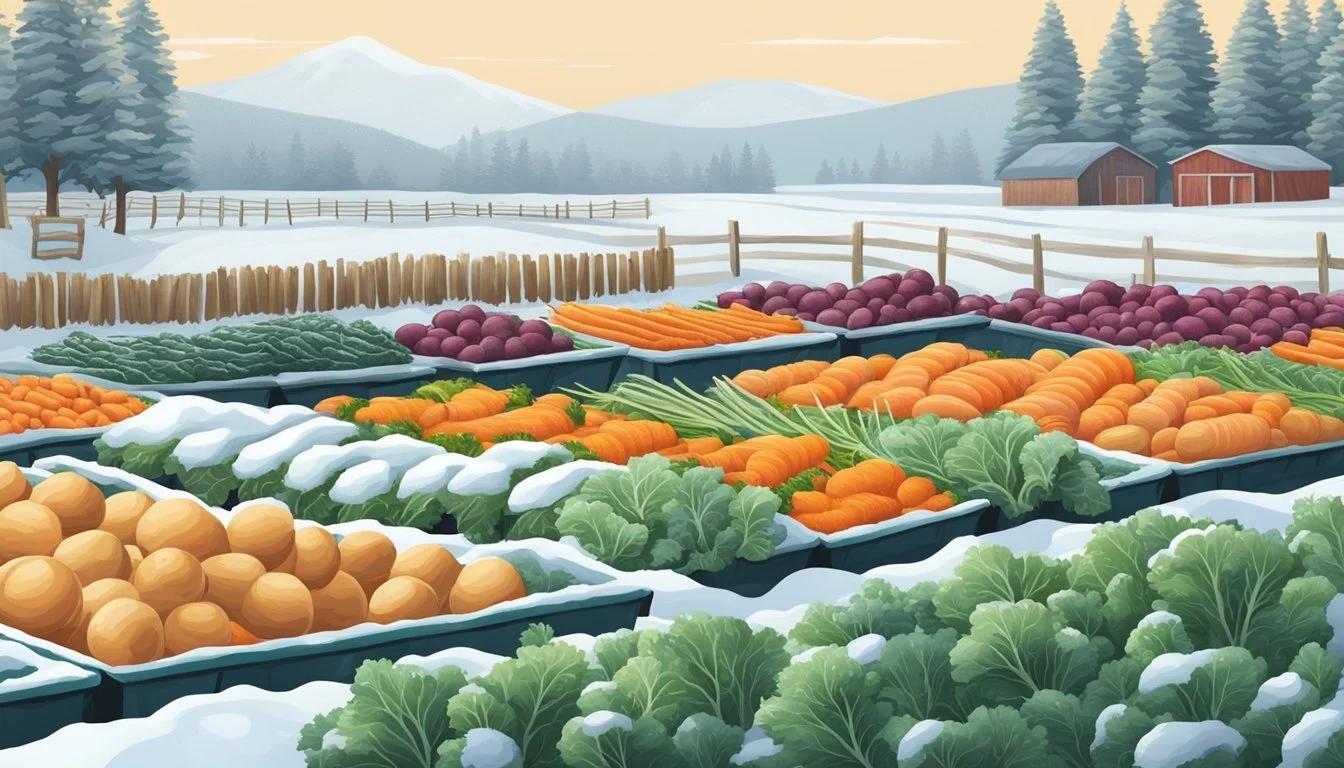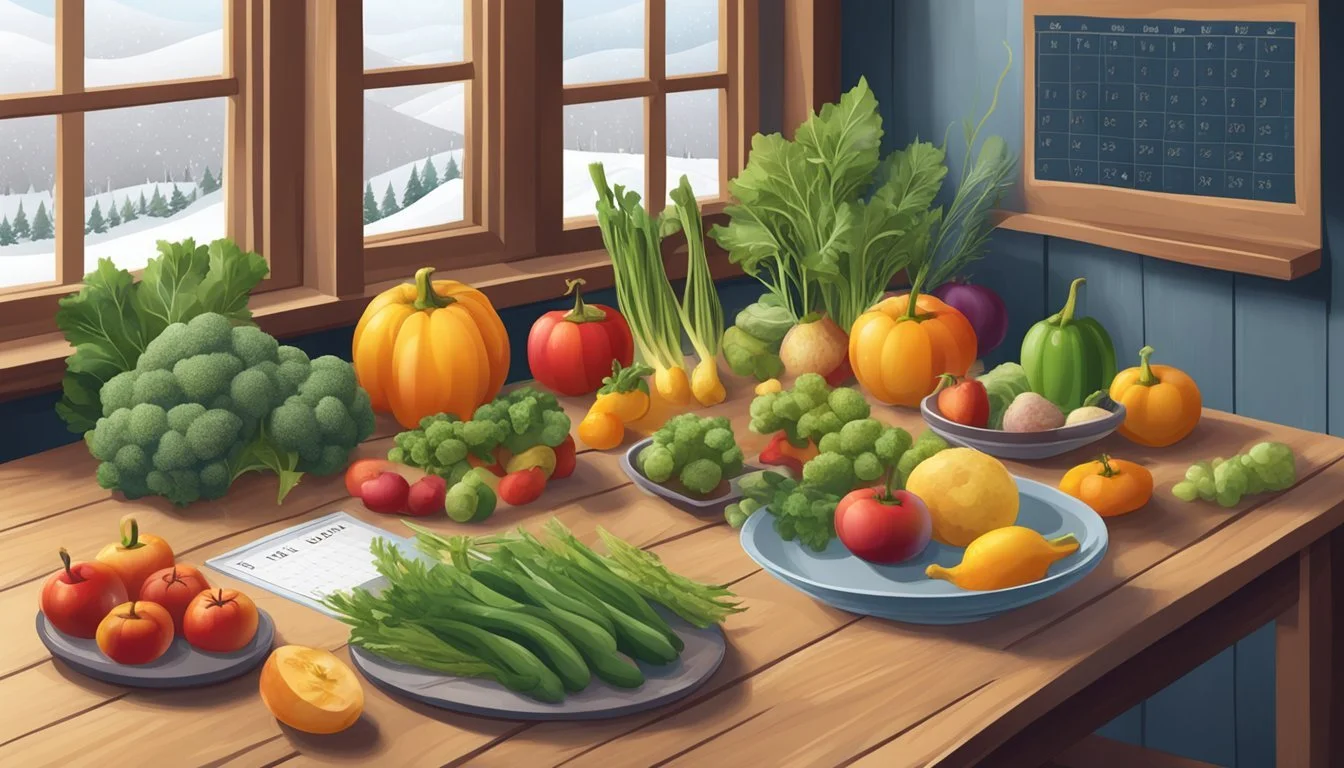Connecticut Seasonal Fruit & Vegetables in February
A Guide to Fresh Produce
This Article is Part of our Connecticut Seasonal Fruit & Veg Calendar
As February blankets Connecticut in winter's chill, the state's produce offerings adapt to the cold. While many associate vibrant produce with summer's warmth, Connecticut's February harvest still provides a range of fruits and vegetables for those looking to eat seasonally. Notably, the state's farms and markets offer hearty vegetables that can withstand the frosty weather.
During this month, Connecticut consumers will find that root vegetables and sturdy greens are center stage. Options such as kale and Brussels sprouts (how long do brussels sprouts last?), along with versatile winter squash, are readily available, having survived the fall and enduring well into the winter months. These vegetables not only offer robust flavors and textures that can be incorporated into warming winter dishes but also contribute essential nutrients during a season when fresh produce might otherwise be scarce.
This selection reflects the state's agricultural resilience and supports the benefits of consuming produce that aligns with the natural growing season. Choosing seasonal fruits and vegetables ensures freshness, supports local farmers, and can lead to a more sustainable way of eating, even during the coldest months of the year in Connecticut.
Understanding Connecticut's Seasonal Produce Calendar
In Connecticut, the month of February is a pivotal time for seasonal produce, marking the end of winter's deep freeze and the beginning of early spring preparations in agriculture. The produce calendar is a crucial guide for both consumers and farmers, aligning consumption with harvest cycles.
February's Place in the Agricultural Year
February is traditionally one of the coldest months in Connecticut, and its place in the agricultural year is unique. During this time, most of the state's farming activities are at a low ebb, with the ground often frozen and outdoor growing largely inactive. However, it represents a transition period where Connecticut farms begin to prepare for early spring plantings. Some winter-hardy vegetables might still be available from local storage or greenhouses, such as root vegetables and select greens.
Typical Produce Available in February:
Root Vegetables: Carrots, turnips, and beets (how long do beets last?) from storage.
Greens: Kale and spinach from greenhouses or cold frames.
Despite a sparse selection of fresh produce, February sets the agricultural groundwork for the months ahead.
The Importance of Seasonal Eating
Seasonal eating aligns with Connecticut's agricultural calendar, which supports local farming and ensures the consumption of fresh, nutrient-rich produce. By understanding this calendar, individuals can make informed choices that benefit personal health, local economies, and the environment.
Advantages of Seasonal Eating in Connecticut:
Freshness: Produce harvested in season is fresher, tastier, and more nutritious.
Support for Local Farms: Buying in-season supports Connecticut farmers during lean months.
Environmental Impact: Seasonal consumption reduces carbon footprint from transportation of off-season imports.
Eating seasonally in February might be challenging due to limited fresh produce, but it serves as an opportunity to support local agriculture through purchasing stored or greenhouse-grown items.
Winter Harvest: Vegetables Available in February
Despite the cold weather, February in Connecticut still offers a variety of vegetables. While the selection may not be as robust as summer months, root vegetables and hardy greens are plentiful and provide both flavor and nutrition.
Root Vegetables and Their Health Benefits
Carrots, turnips, and parsnips thrive in the frigid weather, storing energy in their roots which we harvest as vegetables. They are high in fiber and vitamins such as Vitamin C and A. Especially carrots are known for their beta-carotene content, crucial for maintaining good vision and immune function.
Carrots: High in Vitamin A, supports vision and immunity
Turnips: Good source of Vitamin C, aids in healing and iron absorption
Parsnips: Rich in fiber, supports digestive health
Green Leafy Vegetables in Midwinter
Vegetables like kale, spinach, and collard greens (how long do collard greens last?) are resilient against the February chill. These leafy greens are nutrition powerhouses, offering vitamins such as K, A, C, and folate. Kale provides a particularly impressive amount of Vitamin C, while spinach is an excellent iron source when consumed with Vitamin C-rich foods to enhance absorption.
Kale: High in Vitamin C, supports immune health
Spinach: Rich in iron, important for blood function
Collard Greens: Great source of Vitamin K, essential for bone health
Uncommon Winter Vegetables
Aside from the usual suspects, there are less commonly known vegetables that make their appearance in winter, like leeks and Brussels sprouts. Leeks, a member of the onion family, are milder and add depth to winter dishes, while Brussels sprouts offer a nutty flavor and add variety to the winter plate.
Leeks: Milder alternative to onions, versatile in cooking
Brussels sprouts: Nutty flavor, contains Vitamin K and C
While mushrooms are not vegetables in the botanical sense, they are often categorized with vegetables in culinary uses. Various types of mushrooms can be found during the winter, contributing umami flavor and offering a different nutritional profile, including essential minerals and B vitamins.
Seasonal Fruits to Enjoy During February
In February, those in Connecticut can enjoy a variety of fresh fruits that are perfectly ripe during the winter season. This month highlights the zesty flavors of citrus fruits and offers an opportunity to indulge in some exotic fruits that are at their peak.
Citrus Fruits Peak Season
Citrus fruits come into their own in February. They are not only abundant in supply but also offer a range of health benefits due to their high vitamin C content. Here is what is typically available:
Blood Oranges: Recognized for their deep red flesh and sweet flavor with hints of raspberry.
Lemons: Known for their tartness and versatility in both culinary and non-culinary uses.
Oranges: Rich and sweet, perfect for eating fresh or for juicing.
Grapefruits: Available in varieties from white to pink, offering a range from sweet to tart flavors.
Exotic Fruits for February Consumption
While local produce is limited in Connecticut during February, some exotic fruits reach their peak and can be enjoyed:
Kiwis: With their tangy yet sweet taste, these small fruits add a tropical flair to any dish.
Pomegranates: Known for their jewel-like seeds and sweet-tart flavor, which make them a valuable addition to salads and desserts.
Cooking and Preparing Seasonal February Produce
Utilizing seasonal produce from Connecticut in February not only ensures the freshest flavors but also aligns with local harvest cycles. This selection of winter vegetables can form the basis for nutritious meals and traditional regional dishes.
Creating Nutritious Winter Meals
Connecticut’s winter farmers markets offer a bounty of hearty vegetables like kale, cauliflower (how long does cauliflower last?), broccoli (how long does broccoli last?), and beets, ideal for creating fulfilling and wholesome meals. When cooking these seasonal greens, one can opt for sautéing with a fragrant mix of garlic and olive oil, which enhances their natural flavors while preserving their nutrients.
Kale can be transformed into vibrant smoothies or added to salads for an iron-rich pick-me-up.
Roasted cauliflower and broccoli, seasoned with herbs, make for simple yet satisfying side dishes.
Beets can be boiled or roasted to bring out their natural sweetness and are excellent in both savory applications and desserts.
Pairing these vegetables with grains or legumes can create a well-rounded dish that is both satisfying and nutritious.
Traditional Connecticut Recipes Featuring Seasonal Produce
Connecticut’s culinary tradition showcases the versatility of February produce in a variety of dishes.
Leek recipes, such as potato leek soup, offer a comforting meal on chilly February evenings.
Winter squash, another February favorite, serves as the centerpiece in hearty stews and can also be found in traditional pies.
For those with a sweet tooth, squash and beets can sneak into desserts, providing natural sweetness and moist textures to cakes and baked goods.
Below is a table highlighting ways to include these seasonal ingredients in traditional Connecticut recipes:
Ingredient Dish Type Preparation Method Kale Salad, Smoothie Raw, Blended Cauliflower Side Dish Roasted with Herbs Broccoli Side Dish Sautéed with Garlic Beets Dessert Roasted, Pureed Leeks Soup Simmered in Broth Winter Squash Stew, Pie Baked, Pureed
Experimenting with these ingredients in tried-and-tested recipes allows one to appreciate the full range of flavors and textures they have to offer.
Planning Ahead
As February's chill persists in Connecticut, gardeners and fresh produce enthusiasts alike anticipate the vibrant array of fruits and vegetables that spring will soon deliver. Strategic preparation at this time lays the foundation for a bountiful harvest in the months to come.
Looking Forward to Spring Produce
Spring Month Produce to Anticipate April Radishes, Lettuce, Thyme May Asparagus (how long does asparagus last?), Peas June Rhubarb, Arugula
Preparing the Garden for Early Plantings
Gardeners in Connecticut take February as an opportune time to start preparing their garden beds. The soil needs to be cleared of any winter debris and amended with compost to replenish nutrients. Frost-resistant crops such as lettuce and radishes can be considered for early plantings, as they can tolerate the cooler temperatures common during late February and early March. Planning the garden layout with regard to sunlight and drainage ensures that come April, when more tender crops can be seeded, the garden is optimally prepared to support their growth.
Connecticut Food and Farming Education
Connecticut's agricultural sector prioritizes education through various programs and public involvement initiatives. These efforts aim to promote understanding of seasonal eating habits and support the vitality of local farms.
Agricultural Programs and Outreach
Numerous programs spearheaded by the Connecticut Department of Agriculture are designed to educate both young and old about farming practices and the importance of agriculture in the state. Local farms often collaborate with educational institutions to offer hands-on experiences, workshops, and field trips that align with the state's commitment to agricultural education. These programs not only provide valuable knowledge but also aim to foster future generations' interest in farming as a career.
Educational Outreach Activities Include:
Farm visits and tours
Classroom presentations by farmers or department representatives
Agricultural career fairs for students
Seasonal Eating and Community Involvement
Community involvement plays a critical role in Connecticut's approach to promoting seasonal eating habits. Programs such as SNAP4CT and community-supported agriculture (CSA) allow residents to directly engage with local farms, supporting them by purchasing seasonal produce. This not only leads to a better diet plan for individuals but bolsters the local economy and farming community.
Community Initiatives Feature:
Nutrition education emphasizing the benefits of seasonal produce
Local markets where consumers can buy directly from farmers
Events focused on cooking and food preservation techniques
By highlighting local produce availability and educating the community about the benefits of seasonal eating, these programs cultivate a strong connection between consumers and the local agriculture industry.
Where to Find Connecticut's Seasonal Produce
In Connecticut, February's seasonal produce can be most commonly found at local farmers' markets and in the dedicated local produce sections of grocery stores. These venues support local farms, strengthen the state economy, and provide consumers with fresh, regional food options.
Local Farmers' Markets
Farmers' markets across Connecticut are a prime destination for locally-grown fruits and vegetables. They typically operate even during colder months, offering produce like root vegetables and greenhouse-grown items. Consumers can find a comprehensive list of farmers' markets through the Connecticut Department of Agriculture's website or by visiting local community boards.
Notable Connecticut Farmers' Markets:
Hartford Regional Market
CitySeed's Wooster Square Farmers Market in New Haven
Stamford Museum & Nature Center Farmers' Market
Grocery Stores with Local Produce Sections
Many grocery stores in Connecticut feature sections dedicated to local produce, distinguishing them from imported goods. These sections are often clearly marked and support Connecticut's agricultural industry. Shoppers can find seasonal items sourced from state farms, providing a convenient and reliable option for those who may not have access to a nearby farmers' market.
Grocery Stores Known for Local Sections:
ShopRite: Offers an array of local produce with clear "Connecticut Grown" labeling.
Whole Foods Market: Often highlights local produce and could include seasonal Connecticut-grown items.
Big Y: Known for their commitment to local farmers by stocking seasonal produce from within the state.
Benefits of Eating Seasonally in Connecticut
Choosing to eat seasonally in Connecticut provides key benefits in terms of nutrition and sustainability. Residents can enjoy fresh produce that supports local agriculture and contributes positively to the state's economy and environment.
Nutritional Advantages
Seasonal fruits and vegetables harvested at their peak in Connecticut offer a bounty of nutrients. These food items contain more vitamins and minerals because they are sold shortly after harvest, ensuring they retain their natural goodness. For example, winter crops such as kale and Brussels sprouts are high in vitamins A and C.
Winter Season Produce:
Kale: Vitamin A, Vitamin C
Brussels sprouts: Vitamin K, Vitamin C
Eating according to the season introduces a diverse range of produce into one’s diet, which can contribute to a broader intake of essential nutrients.
Environmental and Economic Impact
Seasonal eating bolsters Connecticut’s economy by supporting local farmers and reducing transportation costs. Fewer food miles mean a smaller carbon footprint and less environmental degradation, making it a more sustainable choice.
Local Agriculture Support:
Boosts local economy
Reduces transportation emissions
When consumers purchase locally-grown seasonal produce, they contribute to the maintenance of farmland within the state. This practice also encourages a market for diverse crop varieties, which can benefit the soil and local ecosystems.
Conclusion
In February, the options for locally grown produce in Connecticut are limited due to the cold climate and short daylight hours. However, consumers can still find some fruits and vegetables that are in season during this winter month.
Citrus fruits, such as lemons and oranges, are at their peak and provide a burst of brightness and vitamin C. While they are not locally grown in Connecticut due to the climate, they are seasonally appropriate options with high availability.
For local produce, root vegetables that have been stored from the fall harvest are typically available. These may include:
Beets
Carrots
Potatoes
Indoor or greenhouse-grown produce such as greens can sometimes be found and offer freshness and nutrition. These might comprise:
Spinach
Kale
Microgreens
Farmers and vendors in Connecticut work to extend the availability of certain types of produce using methods like cold storage and greenhouse growing. This effort ensures that even in the depths of winter, some fresh options remain accessible.
For those interested in eating seasonally and locally, farmers' markets and specialty stores may provide the best variety of February's seasonal offerings in Connecticut. It is beneficial to support local agriculture and enjoy the freshness of produce that, while more limited at this time of year, is still available.










